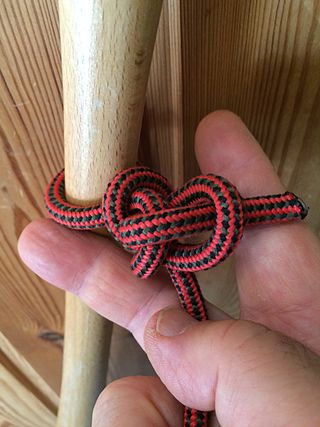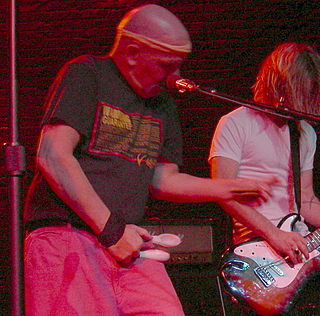Related Research Articles

The farmer's loop is a knot which forms a fixed loop. As a midline loop knot made with a bight, it is related to several other similar knots, including the alpine butterfly knot and artillery loop.

The schottische is a partnered country dance that apparently originated in Bohemia. It was popular in Victorian era ballrooms as a part of the Bohemian folk-dance craze and left its traces in folk music of countries such as Argentina, Finland, France, Italy, Norway ("reinlender"), Portugal and Brazil, Spain, Sweden, Denmark, Mexico, and the United States, among other nations. The schottische is considered by The Oxford Companion to Music to be a kind of slower polka, with continental-European origin.

The twist is a dance that was inspired by rock and roll music. From 1959 to the early sixties it became a worldwide dance craze, enjoying immense popularity while drawing controversies from critics who felt it was too provocative. It inspired dances such as the Jerk, the Pony, the Watusi, the Mashed Potato, the Monkey, and the Funky Chicken, but none were as popular.

Novelty and fad dances are dances which are typically characterized by a short burst of popularity. Some of them, like the Twist, Y.M.C.A. and the Hokey Pokey, have shown much longer-lasting lives. They are also called dance fads or dance crazes.

The Hokey Pokey is a participation dance with a distinctive accompanying tune and lyric structure. It is well-known in English-speaking countries. It originates in a British folk dance, with variants attested as early as 1826. The song and accompanying dance peaked in popularity as a music hall song and novelty dance in the mid-1940s in the UK. The song became a chart hit twice in the 1980s. The first UK hit was by The Snowmen, which peaked at UK No. 18 in 1981.

The Big Apple is both a partner dance and a circle dance that originated in the Afro-American community of the United States in the beginning of the 20th century.

Making the sign of the cross, also known as blessing oneself or crossing oneself, is a ritual blessing made by members of some branches of Christianity. This blessing is made by the tracing of an upright cross or Greek cross across the body with the right hand, often accompanied by spoken or mental recitation of the Trinitarian formula: "In the name of the Father, and of the Son, and of the Holy Spirit. Amen."

"Mary Mack" is a clapping game of unknown origin. It is first attested in the book The Counting Out Rhymes of Children by Henry Carrington Bolton (1888), whose version was collected in West Chester, Pennsylvania. It is well known in various parts of the United States, Australia, Canada, United Kingdom and in New Zealand and has been called "the most common hand-clapping game in the English-speaking world".
"Hitch Hike" is a 1962 song by Marvin Gaye, released on the Tamla label. Another song Gaye co-wrote.
Locking is a style of funk dance. The name is based on the concept of locking movements, which means freezing from a fast movement and "locking" in a certain position, holding that position for a short while and then continuing at the same speed as before. It relies on fast and distinct arm and hand movements combined with more relaxed hips and legs. The movements are generally large and exaggerated, and often very rhythmic and tightly synced with the music. Locking is performance oriented, often interacting with the audience by smiling or giving them a high five, and some moves are quite comical.

Assyrian folk dances are sets of dances that are performed throughout the world by Assyrians, mostly on occasions such as weddings, community parties and other jubilant events.

The falconer's knot is a knot used in falconry to tether a bird of prey to a perch. Some sources show this knot to be identical to the halter hitch, but with a specific method of single-handed tying needed when the other hand is occupied holding the bird.
Contra dance choreography specifies the dance formation, the figures, and the sequence of those figures in a contra dance. The figures repeat, ideally, in a graceful flowing pattern, aligned with the phrasing of the music. Contra dance figures do not have defined footwork; within the limits of the music and the comfort of their fellow dancers, individuals move to the beat and embellish according to their own taste. Much of the dance is done as a walking movement, one step for each count of the music, while the arms and hands do most of the changing, most of these involving connecting with others' hands.

Finger-counting, also known as dactylonomy, is the act of counting using one's fingers. There are multiple different systems used across time and between cultures, though many of these have seen a decline in use because of the spread of Arabic numerals.

Spoons can be played as a makeshift percussion instrument, or more specifically, an idiophone related to the castanets. They are played by hitting one spoon against the other.
The promenade position is a dance position in ballroom and other dances. It is described differently in various dance categories.
The cup game is a children's clapping game that involves tapping and hitting a cup using a defined rhythm. The game can be played by many players seated around a table and is often played in large groups. Each player possesses a cup and in unison the players tap out the defined rhythm using their cups. It can be played competitively, where the rhythm speeds up in each "round", and a player making a mistake in the rhythm must drop out of the game, with a new "round" starting after each elimination, and game play continuing until only one player remains, with that player being the winner.
Magnamanus is an extinct genus of herbivorous iguanodontian dinosaur that lived during the Early Cretaceous in what is now Spain in the Golmayo Formation. It contains a single species, Magnamanus soriaensis.
References
- ↑ Sixties Dance and Dance Craze, Sixties City. Archived 2012-03-24 at the Wayback Machine